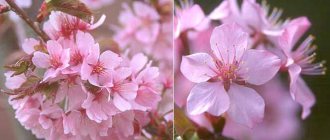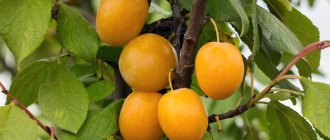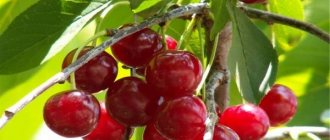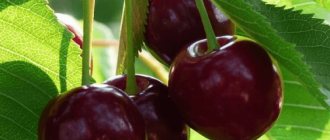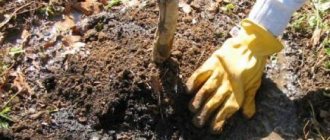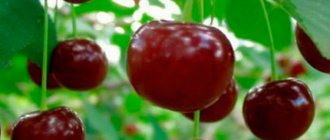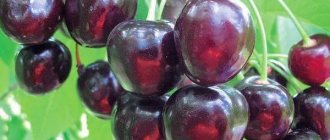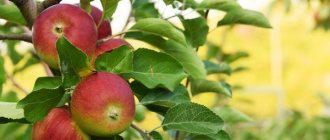Description
Bush steppe cherry grows as a low shrub and does not exceed a height of 1.5 meters. The crown of the bush is very lush and beautiful, resembling a ball in appearance, the root shoots are quite voluminous. Cherry shoots tolerate winter well after full ripening; the shrub sheds its leaves in the fall, before severe frosts set in.
Steppe cherries are unpretentious; even infertile lands and rocky soils cannot prevent a high yield. Loves the sun, tolerates periods of drought well, does not require special care. Bush cherries are sometimes called ornamental cherries because of their abundant flowering and beauty, the perfect shape of their shiny ruby berries.
The shrub species is easy to distinguish from others not only by size, but also by some characteristic features. In young shoots, the bark has a gray tint with red splashes at the top, while in adults the color of the bark is yellowish, sometimes closer to brown.
The flowering of steppe cherries in central Russia begins in May and lasts about a week. As a rule, the plant needs pollinators and is partially self-fertile.
The shape of bush cherry fruits resembles a ball; they come in different shades, from yellowish to red and dark burgundy. The skin is shiny, the taste of the berry is a little more sour than other varieties, and sometimes there is some tartness. As a rule, fruit ripening occurs in the first half of July.
Bush cherries begin to bear fruit a minimum of 3 years, and a maximum of five years from the date of planting. If conditions are favorable, cherries have a lifespan of up to 20 years, and the root shoots are actively renewed. The plant propagation method is vegetative-root.
Fact! This variety of cherry is rightfully recognized as the most cold-resistant, because the plant can withstand temperatures up to -60 degrees!
Types of cherries
- Felt cherry . Many people know it as Chinese. The homeland of this cherry is Northwestern China and Japan. It grows as a tree or shrub 2–3 meters high. Annual shoots, leaves and berries are pubescent. Very decorative all season. The berries are on a short stalk, bright red, sweet. Winter hardiness is high, but life expectancy is short, only 10 years.
- Ferruginous cherry . A low shrub up to one and a half meters high. Distributed in the Russian Far East, China, Korea and Japan. At the base of the leaf there are small growths called glands, which gives the plant its name. The branches are thin, flexible, curved towards the ground. The bush looks like a small tent. The fruits are edible, almost black in color. Drought- and frost-resistant, lives up to 100 years. It is cultivated in the Urals, Crimea and the Caucasus. Very decorative and widely used in landscape planning.
- Dwarf or sand cherry . A low shrub up to 1.5 m high. Flowering is long-lasting, up to three weeks. The fruits are purple-black and edible. Frost and drought resistant. Undemanding to soils. Due to its high decorative value, it is used in landscaping.
- Kuril cherry . It grows on Sakhalin, the Kuril Islands and Japan. It reaches a height of two meters. Flowering begins before the leaves appear. The fruits are small and have a bitter taste. Used for landscaping. Frost resistance is high.
- Bush or steppe cherry . Shrub up to two meters high. It blooms for 12–15 days. Distributed in the European part of Russia over a large area, in the north in the Solikamsk region, in the Urals and Altai. The color of the fruit varies, from yellow to almost black. Winter-hardy, drought-resistant. Practically not affected by diseases and pests. Gives a lot of growth.
- Maksimovic's cherry . Grows in the Far East, Sakhalin, Kuril Islands, Northern China, Korea and Japan. Tree up to 15 meters high. The fruits are small and inedible. Shade-tolerant and winter-hardy. Tolerates urban gas pollution well. Grows well in Central Russia and further south. Used for landscaping in parks and squares.
- Common cherry . It is not found in the wild, but is widely grown as a fruit and ornamental tree. The height reaches 10 meters. It blooms for up to three weeks, the fruits are dark red, fleshy, sweet and sour taste. Grows quickly. Resistant to frost and drought. In addition to a large number of varieties grown for berries, there are also purely decorative forms. Terry has white semi-double flowers. The spherical crown has a round crown and small leaves. Raxa cherry has white double flowers . Willow has leaves up to 13 cm long and only 3 cm wide. Peach-flowered is covered with bright pink flowers in spring. Variegated cherry has leaves with yellow or white streaks. Always blooming does not produce fruit, but blooms all summer.
- Bird cherry or sweet cherry . It grows wild in Western Ukraine, Crimea, the Caucasus, Asia and southern Europe. It is grown in cultivation for fruit production and as an ornamental plant. The tree is tall, up to 35 meters. Blooms for 10–14 days. The fruits are dark red to almost black. Varieties with different colors of berries have been developed. Grows quickly. Frost-resistant. There are decorative forms used for landscaping and landscaping. Willow, double, low (dwarf), fern-leaved (leaves deeply dissected), variegated (with yellow and white strokes on the leaves), pyramidal and weeping.
- Sakhalin cherry . The height of the tree reaches eight meters. Its fruits are small, black, tasteless. Used for landscaping only. Frost resistance is high. Adapts well to polluted urban environments.
- Gray cherry . Grows in Transcaucasia and Turkey. Low, up to one and a half meters, shrub. On the reverse side of the leaves there is a white felt pubescence (hence the name: hoary). The flowers are pink-red. The fruits are small, dry, dark red in color. Used for landscaping and landscape planning.
- Japanese cherry . The famous sakura grows in China and Japan. It occurs as a shrub or low tree. Used only as an ornamental plant. Its fruits are not edible. Very thermophilic, in central Russia it can only be grown with shelter for the winter.
- Hill cherry . It is a hybrid of bush and bird cherry. The fruits are black-red, fleshy, sweet and sour. It is cultivated everywhere, right up to the Karelian Isthmus. Vladimirskaya cherry belongs to this species. It has become widespread. By crossing Vladimirskaya with Winkler cherries, the “Beauty of the North” variety was obtained with a high degree of frost resistance, which allows it to be successfully grown in the harsh conditions of Siberia.
- Tien Shan cherry . A low-growing shrub, common in Central Asia in the mountainous regions of the Pamirs and Tien Shan. Very unpretentious. Can grow on poor sandy and rocky soils. The fruits are small, not juicy, dark red in color. Drought and frost resistant. In central Russia it can be grown without shelter for the winter. Used for landscaping and strengthening slopes.
- Cherry almond blossom . Dense shrub only 20–30 cm high. Pink flowers. The fruits are dark red, juicy and tasty. Frost resistance is high. Widely used in landscape planning as a border plant and in combination with coniferous and deciduous trees and shrubs, as well as for the design of alpine slides and rockeries.
- Cherry Bessea . Shrub up to 1.2 meters in height. Grows in North America. Flowering is long, up to 20 days. The fruits are almost black in color and quite edible. Grows quickly. Frost and drought resistant. Decorative throughout the season. Widely used as a crop and in landscaping.
- Cherry warty . Low-growing shrub from 0.5 to 1 meter tall. Grows in the mountains of Central Asia, the Pamirs and Tien Shan. The fruits are dark red, juicy, with a pleasant sweet and sour taste. Winter hardiness is high. In the conditions of the Moscow region it copes well without shelter.
Photo gallery: main varieties of cherries
Felt cherry branches strewn with berries
Ferruginous cherry is very decorative when in bloom.
A small bush of dwarf cherry is covered with dark berries
The blooming thickets of Kuril cherries are incomparable
Almond cherry blossoms pink
Dark cherry fruits attract birds
The legendary Japanese cherry tree (sakura) is a symbol of Japan.
The discreet mountain shrub of the Tien Shan cherry is beautiful in bloom
Characteristics of varieties
It is worth highlighting the most popular varieties of bush cherries.
Cherry Subbotinskaya
The unique bush cherry of the Subbotinskaya variety is unpretentious and withstands cold and periods of drought with dignity. The fruits are universal in their purpose and do not suffer during transportation. The berries have a refined sweet and sour taste; they ripen in the second half of July. The yield indicators are quite high; from one bush you can get a minimum of 6.5 and a maximum of 12 kg of harvest. The shrubby tree-like cherry Subbotinskaya is worthy of the attention of gardeners.
Vuzovskaya
The taste of cherry pulp is sweetish and sour, the fruits are most often dark red in color. The berries are quite small, have an unusual shape, slightly flattened on the sides. Each inflorescence of the variety contains 3-4 white flowers.
The leaves of the tree cherry are narrow, with slightly pointed ends. The bark of this variety is quite smooth, gray in color, sometimes there are lentils on it, but they are not clearly visible. The shape of the fruit resembles an oval; the shrubs of the plant, with rare exceptions, are of medium density.
Shadrinskaya
The Shadrinskaya cherry bush is distinguished by horn-shaped flowers, of which up to 5 pieces are formed in each inflorescence. The leaves of the plant are medium in size, shaped like an ellipse, most often the end of the leaf is pointed. Cherry shoots are medium in thickness, the crown is very beautiful, resembling a ball, the brown bark is quite smooth, sometimes there is a gray coating. Cherry is a medium-sized variety; its height most often reaches 1.85 m.
The description of Shadrinskaya cherry resembles a bush more than a tree.
Maksimovskaya
The Maksimovskaya cherry bush is shaped like a pyramid. It reaches a height of 2.4 meters. The crown is not too dense, but not sparse either. Large grayish lenticels are sometimes found on the brown bark. The leaves of the Maksimovskaya cherry are quite large, oblong and smooth.
Zhukovskaya
Tree Zhukovskaya cherries are rightfully considered universal; the fruits are widely used in cooking and have a very delicate sweet and sour taste. The berries are large in size and can weigh up to 6 g. The variety is self-pollinating; in addition, it is quite unpretentious and has immunity to diseases such as ring spot and coccomycosis. Zhukovskaya cherry brings a generous and high-quality harvest.
Chocolate girl
From the fruits of this variety they make excellent jam, delicious marshmallows, liqueurs and other drinks. The taste of the berries is quite unusual, sweet, but with sourness, a little bitter, which gives the cherry a piquancy. The fruits are large, reaching 3-4 g in weight. The variety is classified as low-growing, cherries do not grow higher than 2.4 meters.
The fruits are round in shape, the skin of the berries is dark red, sometimes almost black. The chic cherry bush Shokoladnitsa is worth planting on your site because of its yield and excellent taste of the fruit.
Blizzard
This variety is incredibly resistant to difficult weather conditions and is quite unpretentious. Metelitsa berries are scarlet in color, the pulp is sweet, with a slight sourness. The weight of the fruit ranges from 2.5 to 4 g, the difference largely depends on the season; both medium and large berries are found. The shrub variety is self-pollinating and is considered one of the most popular among gardeners.
Altai
This dwarf cherry variety belongs to the “Siberian” hardened plants. It is quite hardy and can withstand even the harshest winters. The yield rate is consistently high, even under unfavorable weather conditions. The bushy Altai cherry is worthy of the attention of amateur gardeners.
Important! Altai cherries need pollinators!
The fruits are oval in shape, the skin is very bright red. The berries are not very heavy, only about 2.5 g. Not everyone can eat these cherries fresh because of their rich sour taste. Most often they are processed and prepared into jam, marmalade and drinks. From one bush you can get up to 6.5 kg of harvest.
BRUSH CHERRY: ALL FEATURES OF GROWING AND CARE bookmarks 8
In domestic gardens, the most common type of cherry is the common tree and shrub form; less often, gardeners grow bush (steppe) and felt cherries, and other varieties of cherries are not at all popular.
Steppe cherry is a low shrub with a spreading spherical crown. If the height of an ordinary cherry can reach four to six meters, then a bush cherry grows only up to one and a half to two meters, and a lot of root shoots usually form next to it, due to which the bush is renewed over time.
